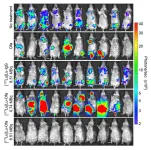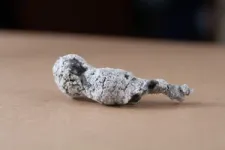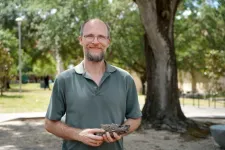(Press-News.org) Reston, VA—A new nuclear medicine therapy can cure human non-Hodgkin lymphoma in an animal model, according to research published in the April issue of The Journal of Nuclear Medicine. A single dose of the radioimmunotherapy, [177Lu]Lu-ofatumumab, was found to quickly eliminate tumor cells and extend the life of mice injected with cancerous cells for more than 221 days (the trial endpoint), compared to fewer than 60 days for other treatments and just 19 days in untreated control mice.
Non-Hodgkin lymphoma is a common blood malignancy. The American Cancer Society estimates that more than 80,500 new cases and 20,100 deaths will occur in the United States in 2023. The standard of care for many non-Hodgkin lymphoma patients involves chemotherapy and immunotherapy targeting the CD20 protein, which is highly expressed on most non-Hodgkin lymphoma cells.
“Although this chemotherapy with immunotherapy combination is usually initially effective, many patients don’t respond or relapse, so we need improved therapies,” said Richard L. Wahl, MD, the Elizabeth E. Mallinckrodt Professor and director of Mallinckrodt Institute of Radiology at Washington University School of Medicine in St. Louis, Missouri.
In the study researchers labeled ofatumumab, a recently developed anti-CD20 fully human antibody, with 177Lu, a widely used therapeutic radioisotope that can kill cancer cells. They then determined the in vitro characteristics of [177Lu]Lu-ofatumumab, estimated human dosimetry, and evaluated its therapeutic effectiveness for non-Hodgkin lymphoma in a mouse model.
The most significant finding of the study came from the preclinical therapy trial. Mice injected with human B cell lymphoma were either untreated, treated with unlabeled ofatumumab, treated with 8.51 MBq of [177Lu]Lu-IgG, or treated with 0.74 MBq or 8.51 MBq of [177Lu]Lu-ofatumumab. The best results occurred with 8.51 MBq of [177Lu]Lu-ofatumumab, for which the median survival was more than 221 days, essentially curing the mice. The median survival of untreated mice and those treated with unlabeled ofatumumab, [177Lu]Lu-IgG, and 0.74 MBq of [177Lu]Lu-ofatumumab was 19, 46, 25 and 59 days, respectively.
“What’s more, in mice treated with 8.51 MBq of [177Lu]Lu-ofatumumab, detectable tumors were eliminated completely within two days. Mice treated with the other therapies or left untreated, on the other hand, continued to show tumor cells present,” Wahl explained.
Researchers were able to produce [177Lu]Lu-ofatumumab with high yield and high purity. It showed favorable in vitro characteristics and dosimetry estimates that support the feasibility of human translation.
“The excellent therapeutic results in this animal model of human B cell lymphoma suggest that this curative treatment should be tested in humans with non-Hodgkin lymphoma,” noted Wahl. “If testing is successful in humans, this would represent an excellent new treatment option for patients with this disease.”
This study was made available online in November 2022.
The authors of “Cure of disseminated human lymphoma with [177Lu]Lu-ofatumumab in a preclinical model” include Kyuhwan Shim, Mark S. Longtine, Diane S. Abou, Mark J. Hoegger, and Richard S. Laforest, Mallinckrodt Institute of Radiology, Washington University, St. Louis, Missouri; Daniel L. J. Thorek, Mallinckrodt Institute of Radiology, Washington University, St. Louis, Missouri, and Department of Biomedical Engineering, Washington University, St. Louis, Missouri; and Richard L. Wahl, Mallinckrodt Institute of Radiology, Washington University, St. Louis, Missouri, and Department of Radiation Oncology, Washington University, St. Louis, Missouri.
Visit the JNM website for the latest research, and follow our new Twitter and Facebook pages @JournalofNucMed or follow us on LinkedIn.
###
Please visit the SNMMI Media Center for more information about molecular imaging and precision imaging. To schedule an interview with the researchers, please contact Rebecca Maxey at (703) 652-6772 or rmaxey@snmmi.org.
About JNM and the Society of Nuclear Medicine and Molecular Imaging
The Journal of Nuclear Medicine (JNM) is the world’s leading nuclear medicine, molecular imaging and theranostics journal, accessed 15 million times each year by practitioners around the globe, providing them with the information they need to advance this rapidly expanding field. Current and past issues of The Journal of Nuclear Medicine can be found online at http://jnm.snmjournals.org.
JNM is published by the Society of Nuclear Medicine and Molecular Imaging (SNMMI), an international scientific and medical organization dedicated to advancing nuclear medicine and molecular imaging—precision medicine that allows diagnosis and treatment to be tailored to individual patients in order to achieve the best possible outcomes. For more information, visit www.snmmi.org.
END
Preprints allow for free and rapid dissemination of publicly funded research results, and federal agencies should include them in their public access policies as they look to meet the requirements of the US Office of Science and Technology Policy “Nelson Memorandum.” arXiv–the e-print repository for physics, math, computer science and other disciplines–and bioRxiv and medRxiv–preprint servers for biology and the health sciences–address the unique role of preprints and the value they bring as they release their responses to the Nelson Memo.
“US ...
A University of Texas at Arlington researcher is working to create a process that uses seawater to remove carbon dioxide from the atmosphere.
Erika La Plante, assistant professor in the Materials Science and Engineering Department, received a $125,000 subgrant from the University of California–Los Angeles (UCLA) as part of a larger Department of Energy Advanced Research Projects Agency-Energy grant for the work.
The UCLA team developed a continuous electrolytic pH pump that uses high-alkalinity seawater with high concentrations of carbon dioxide and cations ...
A National Institutes of Health (NIH) clinical trial was stopped early because a daily statin medication was found to reduce the increased risk of cardiovascular disease among people living with HIV in the first large-scale clinical study to test a primary cardiovascular prevention strategy in this population. A planned interim analysis of data from the Randomized Trial to Prevent Vascular Events in HIV (REPRIEVE) study found that participants who took pitavastatin calcium, a daily statin, lowered their risk of major adverse cardiovascular ...
TAMPA, Fla. (April 11, 2023) – After lightning struck a tree in a New Port Richey neighborhood, a University of South Florida professor discovered the strike led to the formation of a new phosphorus material. It was found in a rock – the first time in solid form on Earth – and could represent a member of a new mineral group.
“We have never seen this material occur naturally on Earth – minerals similar to it can be found in meteorites and space, but we've never seen this exact material anywhere,” said geoscientist Matthew Pasek.
In a recent study published in Communications Earth & Environment, Pasek examines ...
Natural gas supplies 32% of all primary energy in the United States, its share of electricity generation having nearly doubled from 2008 to 2021. The cross-country natural gas pipeline system used to be powered mainly by natural gas, but recently has switched in places to electric power. The natural gas pipeline system has generally been much more reliable than the electric power system. The new dependence on electricity has created a vulnerability during hurricanes and other events that can take out electric power, since lack of natural gas may in turn cause gas-powered electric ...
Researchers at Baylor College of Medicine and collaborating institutions report in the journal Nature Communications how a mutation in the enzyme SKD3 can cause a form of a genetic disease known as 3-methylglutaconic aciduria (MGCA7). MGCA7 is an inborn error of metabolism associated with variable neurologic deficits and an abnormally low number of immune cells called neutrophils in the blood. The latter condition, known as neutropenia, can lead to increased susceptibility to infection and can also develop into leukemia, as well as early death in infants.
“SKD3 is essential to protein quality control in animal cells. It removes damaged proteins in structures or organelles ...
Key Takeaways:
Consumers differ in the way that they shop: some “showroom” by figuring out what they want at one kind of retail outlet and buying elsewhere; others conduct deep research and buy where they first find what they like; and other kinds of consumers are less particular and conduct only fairly limited research.
Consumers who are less choosy may shop at stores that have fewer selections, as long as they can pay a lower price for what they buy. This is the one group of consumers most likely to influence price.
BALTIMORE, MD, April 11, 2023 – It’s ...
WASHINGTON — Researchers have developed a new chip-sized microwave photonic filter to separate communication signals from noise and suppress unwanted interference across the full radio frequency spectrum. The device is expected to help next-generation wireless communication technologies efficiently convey data in an environment that is becoming crowded with signals from devices such as cell phones, self-driving vehicles, internet-connected appliances and smart city infrastructure.
“This new microwave filter chip has the potential to improve wireless communication, such as 6G, leading to faster internet connections, better overall communication ...
In Switzerland, one in three employees suffers from workplace stress. Those affected often don’t realise that their physical and mental resources are dwindling until it’s too late. This makes it all the more important to identify work-related stress as early as possible where it arises: in the workplace.
Researchers at ETH Zurich are now taking a crucial step in this direction. Using new data and machine learning, they have developed a model that can tell how stressed we are just from the way we type and use our mouse.
And there’s more: “How we type on our keyboard and move our mouse seems to be a better predictor of how stressed ...
Among Indigenous, rural non-industrial populations inhabiting the tropical forests of lowland Bolivia, researchers report, there appears to be an optimal balance between levels of food consumption and exercise that maximizes healthy brain aging and reduces the risk of disease.
“We hypothesize that energy gain from food intake was positively associated with late life brain health in the physically active, food-limited world of our ancestors, but that obesity and other manifestations of a Western lifestyle ...







